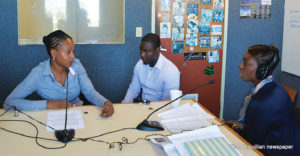 With the hurricane season a few months away, the Department of Disaster Management is looking to build on the lessons learnt from Hurricane Irma.
With the hurricane season a few months away, the Department of Disaster Management is looking to build on the lessons learnt from Hurricane Irma.
“We did an initial assessment in September but we’re currently requesting a national assessment to be done, so all the activities that happen up to December – some are still occurring because we noticed that the Telecoms are still working and ANGLEC is still working to restore the streetlights, so there are still lessons learnt to be captured and we’re expected to get feedback by March 14, so then we’ll have an overarching comprehensives lessons learnt, so we can put a plan of action together to determine where do we go from here,” Melissa Meade, Director of Disaster Management, told Radio Anguilla’s Information Officer, Felicia Hennis, on Monday.
“Right after Irma, when we transitioned from response to recovery we did an assessment on things that went well and things that did not go well,” she stated.
Ms Meade noted there were good collaboration and communication between various agencies and the support from the business community and households to support the efforts of government to return to a state of normalcy.
However she pointed out that both the public and private sector fell short on the aspect of Business Continuity Planning which is an initiative done by the Department every year.
She said the Department has already begun a planning session on contingency of operations for Government so that key essential Departments can be operational during or immediately after a storm.
Addressing the issue of tsunamis, The Head of the Disaster Management office said a model was done if a 100ft tsunami was to impact the island, moving one mile in land stating that persons should move to the various assembly points closest their location – Navigation Hill, Pope Hill, Crocus Hill or Isaccs Cliff.
“If there is a tsunami threat, try to avoid the routes closest to the sea and get inland as quickly to increase your chances of surviving the event,” she advised.
Meade also mentioned that while the Caribbean region has had over 100 tsunamis within the past 500 years, unlike the Pacific we’ve not had the heights they’ve had.
She also stated there is no documented tsunami in the region over 30 feet noting the Department’s Plan caters for much higher than that but strongly urged that the public take the necessary precautions.
The Disaster official insisted, if there is a severe earthquake, where there is increase shaking, persons should immediately pack their necessary documents and snacks and head immediately to the assembly points as there is a strong chance a tsunami may occur.
She emphasized that unlike a hurricane, earthquakes come without a warning and a tsunami may last several hours.
Meanwhile Mr Damian Barker encouraged the public to download the Department’s App – CAPIT to get alerts or warnings if there is a disaster.
He said while they recognize the need for island wide sirens to alert the public, funding is needed for such an initiative.









